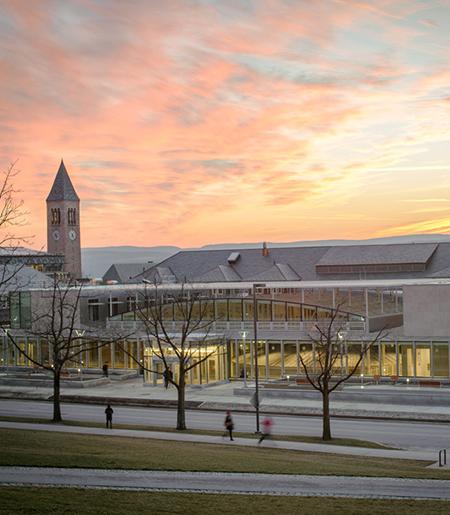The Department of Neurobiology and Behavior is dedicated to exploring, teaching and understanding the neural underpinnings and evolutionary forces that shape animal behavior. The interests of our faculty and students span all levels of organization, from single neurons to complex circuits to whole organisms and societies thereof, and include the impact of hormones and stress on learning and memory, the emergent properties that define behavioral states and govern complex tasks, and the evolution of cooperation, conflict and communication from solitary to highly social organisms.
The department offers a wide range of research opportunities in cellular and molecular neuroscience, systems neuroscience, computational neuroscience, neuroethology and endocrinology, behavioral, sensory and cognitive ecology, sociobiology, sexual selection, chemical ecology and the evolution of species boundaries. Our teaching mission is to integrate most of these themes into two flagship courses, BioNB 2210 (Introduction to Behavior) and BioNB 2220 (Introduction to Neuroscience), and to explore them in greater depth in our upper level courses. These traditional strengths in research and teaching, combined with the recent hires of exciting new faculty members, have positioned NBB as a leader in the emerging science of the brain.
Department websiteLindsay Karaba
Graduate Student
Naman Agrawal
Graduate Student
Antonio Fernandez-Ruiz
Nancy and Peter Meinig Family Investigator in the Life Sciences, Assistant Professor
Publications
- Sharif F, Tayebi B, Buzsáki G, Royer S, Fernández-Ruiz A. (2020). Subcircuits of deep and superficial CA1 place cells support efficient place coding across heterogeneous environments. bioRxiv
- Oliva A, Fernández-Ruiz A, Leroy F, Siegelbaum S. Hippocampal CA2 ripples reactivate and promote social memory. Nature, in press.
- Fernández-Ruiz A, Oliva A, Fermino de Oliveira E, Rocha-Almeida F, Tingley D, Buzsáki G. (2019) Long-duration Hippocampal Sharp Wave Ripples Improve Memory. Science 364(6445),1082-1086.
- Senzai Y, Fernández-Ruiz A, Buzsáki G. (2019) Layer-specific physiological features and interlaminar interactions in the primary visual cortex of the mouse. Neuron 101,1-14.
- Fernández-Ruiz A, Oliva A, Nagy GA, Maurer AP, Berényi A, Buzsáki G. (2017) Entorhinal-CA3 dual-input control of spike timing in the hippocampus by theta-gamma coupling. Neuron, 93:1213-1226.
Hongyu (Amy) Chang
Graduate Student
Ben Sandkam
Assistant Professor
Publications
Sandkam BA, Campello L, O’Brien C, Nandamuri SP, Gammerdinger W, Conte M, Swaroop A, Carleton KL. 2020. Tbx2a Modulates Switching of RH2 and LWS Opsin Gene Expression. Molecular Biology and Evolution 37(7):2002–2014.
Darolti I, Wright AE, Sandkam BA, Morris J, Bloch NI, Farré M, Fuller RC, Bourne GR, Larkin DM, Breden F, Mank JE. Extreme heterogeneity in sex chromosome differentiation and dosage compensation in livebearers. Proceedings of the National Academy of Sciences 116(38)19031-19036.
Wright, AE, I Darolti, NI Bloch, V Oostra, B Sandkam, SD Buechel, N Kolm, F Breden, B Vicoso, JE Mank. 2017. Convergent recombination suppression suggests a role of sexual selection in guppy sex chromosome formation. Nature Communications 8: 14251
Sandkam, BA, CM Young, and F Breden. 2015. Beauty in the eyes of the beholders: colour vision is tuned to mate preference in the Trinidadian guppy (Poecilia reticulata). Molecular Ecology, 24 (3): 596-609.
Sandkam BA, Almeida P, Darolti I, Furman B, van der Bijl W, Morris J, Bourne G, Breden F, Mank JE. 2020. Extreme Y chromosome polymorphism corresponds to five male reproductive morphs. BioRxiv. doi: 10.1101/2020.08.19.258434
Almeida P, Sandkam BA, Morris J, Darolti I, Breden F, Mank JE. 2020. Divergence and Remarkable Diversity of the Y Chromosome in Guppies. Molecular Biology and Evolution. In Press.
Azahara Oliva
Assistant Professor
Publications
- Harvey R, Robinson HL, Liu C, Oliva A, Fernandez-Ruiz A. Hippocampo-cortical circuits for selective memory encoding, routing and replay. Biorxiv, 2022
- Oliva A, Fernandez-Ruiz A, Leroy F, Siegelbaum SA. Hippocampal CA2 sharp-wave ripples reactivate and promote social memory. Nature, 2020
- Fernandez-Ruiz A, Oliva A, Oliveira F, Rocha-Almeida F, Tingley D, Buzsaki G. Long-duration sharp-wave ripples improve memory. Science, 2019
- Oliva A, Fernandez-Ruiz A, Buzsaki G, Berenyi A. Role of Hippocampal CA2 region in triggering sharp-wave ripples. Neuron, 2016
